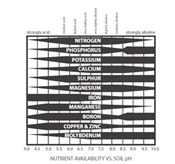Benefits Of Molybdenum Application For Soybean Production In Low pH Soils
RASEL PARVEJ AND DAVID MOSELEY
BATON ROUGE, LOUISIANA
Soil pH is the most important soil quality component that greatly influences soil nutrient availability. Most nutrients are highly available at the soil pH of 6.5 (Figure 1) and most row crops perform at their highest yield potential around this pH level. Soybean production is negatively affected in low pH soils (pH <6.0) due to the low availability of molybdenum (Mo). Like most macronutrients, Mo availability decreases with the decrease of soil pH.
Molybdenum is a vital component of the nitrogenase enzyme that helps Rhizobium bacterial to fix atmospheric nitrogen (N) for soybean plants. Molybdenum deficiency is, therefore, often appeared as N deficiency in soybean and poor nodulation and/or foliar N deficiency symptom in soybean in low pH, acidic soils (pH <6.0) is either due to Mo deficiency or lack of Rhizobium bacteria. Molybdenum is not typically recommended for soybean production in Louisiana since most of Louisiana soils have enough Mo for optimal soybean growth. However, Mo availability is drastically decreased if the soil pH falls below 6.0. The best way to increase Mo availability is to raise soil pH to around 6.5 by applying lime. But lime takes longer time to raise soil pH to the targeted level; therefore, lime application must be done in the previous Fall for soybean production in the Summer.
If lime is not applied in the Fall for a low pH field, Mo application for soybean production in that field can somewhat compensate liming need and maximize atmospheric N fixation. Molybdenum can be applied as seed treatment at planting for soils with less than pH 6.2. Since, treating seed with Mo is a low-cost practice, Mo seed treatment is found to be beneficial in low pH soils, and liming takes longer time to raise soil pH to an optimum level, Mo application is highly recommended in low pH soils regardless of liming practices. However, Mo cannot be used as an alternative of standard liming practices for maintaining or adjusting soil pH. Note that Mo application can only fix Mo deficiency in low pH soils but adjusting pH near neutral by liming can ensure maximum availability of all nutrients. Also, survivability of Rhizobium bacteria is greatly reduced in low pH, acidic soils.
For soybean seed treatment, around 0.2 to 0.4 oz Mo/acre is recommended. If Rhizobium inoculum is used as seed treatment, Mo should not be used as seed treatment unless seeds are planted immediately after treating. Otherwise, Mo salt will reduce the viability of inoculum, resulting in poor nodulation. A similar rate of Mo (0.2 to 0.4 oz Mo/acre) can also be applied onto soybean foliage.
However, Mo is recommended to spray onto soils if seed treatment is not possible/feasible but should be applied at a higher rate (2 to 4 oz Mo/acre) for adequate soil coverage. Molybdenum seed treatment or soil application is better than foliar application since Mo is mostly needed for soil Rhizobium bacterial to fix atmospheric N in soybean. ∆
RASEL PARVEJ AND DAVID MOSELEY: Scientists LSU AgCenter

Figure 1. Soil pH and nutrient availability [Source: Reitsma et al. (2011). Chapter 2: Soil fertility. In: Alternative practices for agronomic nutrient and pest management in South Dakota. Edition: I. South Dakota State University, College of Agriculture and Biological Sciences]